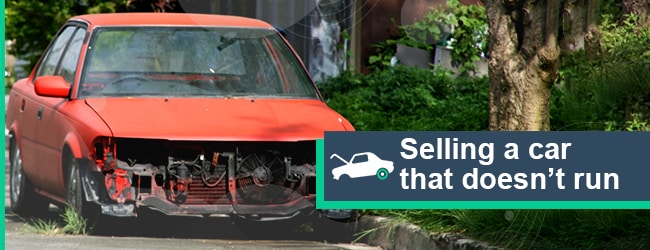Quick Answer:
When trying to sell a car that doesn’t run, the key is identifying the root of the problem and the cost of repair.
Once you know the problem, you can decide if fixing it is worth it or if you should sell the car as it is.
Ways to sell a car that doesn’t run:
- Online: Peddle, Wheelzy, and CarBrain buy cars despite their condition. You get paid within 24-48 hours, but they might offer a bit less than selling privately.
- Privately: it might get you more money, but it will take time and effort.
- Sell as parts: this can be more profitable, but it’s time-consuming and requires mechanical skills.
Key Takeaways:
- Repair Cost Evaluation: Determine if fixing your non-running car is worthwhile by assessing repair expenses versus potential value increases.
- Parting Out Option: If repairs are impractical, consider selling the car for parts, which could be more lucrative but requires technical skills and time.
- Optimal Selling Strategy: Choose a selling method that balances speed and profit. Online platforms offer quick sales but might yield lower returns, while private sales could bring higher prices but require more effort.
Best for Older & Damaged Cars

Buys used, damaged or junk cars
Free tow and no hidden fees
Pays by ACH trasfer or check
Top Pick for Junk Cars

Free, no-obligation cash offers
Offers free paperwork service
Pays on the spot upon pick up
How to Sell a Car That Doesn’t Run
1. Find Out the Cost of Repairs
Before deciding to sell a non-running car, it’s crucial to identify the problem and estimate repair expenses.
Understanding whether the issue is minor or major can significantly affect your selling decision.
- Step 1: Find a reputable local mechanic, preferably experienced with your car’s make and model.
- Step 2: Arrange to transport your car to the mechanic’s shop, using a towing service if the car is non-functional.
- Step 3: After diagnosis, obtain a detailed estimate of the repair costs to assess your next steps.
2. Find Out the Value of the Car
Find out the realistic value of your non-running car in its current state. Check resources like Kelley Blue Book to find the baseline value for your vehicle’s make, model, year, and mileage, assuming it was functioning properly.
Then, deduct an amount based on the car’s cosmetic condition, any known mechanical issues, and the cost of repairs.
The value will depend greatly on what condition the body, interior and tires are in.
Significant rust, dents or accident damage can reduce the value substantially, while an older car in excellent physical shape may still retain decent value even if not running.

3. Decide If Car is Worth Fixing or Selling As-Is
Assessing your car’s current value against repair costs is key to determining whether repairs will significantly boost its value or if selling it “as is” could be more advantageous.
It’s important to evaluate if the effort and cost of repairs are balanced by the expected increase in the car’s selling price. Consider factors such as the car’s age, its brand’s reputation for reliability, and the severity of its issues.
Repairs might be a good investment for newer models or cars known for their desirability and resale value.
However, extensive repairs on older models or those with lower demand might not add enough value to make the repair costs worthwhile.
For instance, if a 2005 Honda Civic has a market value of $2,500 and needs $2,000 in repairs, you need to consider whether the potential $500 increase in value is worth the time and effort.
4. Choose the Best Way to Sell a Car that doesn’t Run
Once you decide on whether to have it repaired beforehand or sell it as a non-running vehicle, explore options for selling it effectively:
1. Sell Car Online
Companies like Peddle, Wheelzy, and CarBrain specialize in buying cars in various conditions, including cars that do not run or have broken parts.
- Fill out the online form: provide the car’s make, model, age, and mileage and describe the condition.
- Accept the offer: you will get an instant cash offer which will be valid for 7 days.
- Schedule car tow: the company will pick up your car from your location within 24-48 hours. This service is free of charge.
- Hand over Certificate of Title: prepare and sign the Title. This is the only required document. Plus, the company will take care of ownership transfer.
- Get paid: you will get paid by cash or check at the time of the car’s pickup.
2. Sell Car Privately
On average, selling a car privately takes about 52 days, but this timeline can extend considerably when selling a car that doesn’t run due to lower buyer interest.
Additionally, selling a car privately entails more steps than selling online and might not yield the expected price.
To sell a car privately:
- Gather the Required Paperwork
- Prepare the Car
- Take Great Photos
- Post Detailed Ad
- Screen Potential Buyers
- Agree on a Safe Payment Method
- Sign the Bill of Sale
- Transfer Title
- Inform DMV about the Sale
Best places to sell a car privately:
- CarGurus – listing price is $4.99
- Autotrader – listing price is $49
- eBay Motors – listing price varies from $19 to $79
- Craigslist – listing price is $5
- Facebook Marketplace – listing is free
3. Sell Car to Salvage Yard
Many junkyards and auto recyclers purchase old, damaged and non-running vehicles. They dismantle and sell usable parts.
Pricing is usually based on vehicle weight, but the condition affects value.
Shopping your car around to a few salvage yards can yield the best price.
5. Gather Required Paperwork
If you choose to sell your car privately, to legally transfer ownership you will need to provide state-specific paperwork.
Commonly, you’ll need a Certificate of Title, record the odometer readings, and present an ID card or driver’s license.
In some states, additional documentation like a valid emissions test certificate, registration tag, and bill of sale may also be required.
While not mandatory, supplementary documents such as service records, VIN checks, or the user’s manual can help demonstrate your car’s value and potentially expedite the sale. In contrast, online car-buying companies typically only require the Certificate of Title to confirm ownership.
Online car-buying companies only require the Certificate of Title to confirm ownership.
6. Agree on Secure Payment Method
To secure payment as the seller, don’t fully release the signed title until funds have cleared your account.
The most secure payment methods:
- Cashier’s Check: A bank-issued cashier’s check offers guaranteed funds, removing the risk of a bounced check.
- Bank Transfer: This method allows direct fund transfer from the buyer’s account to yours, providing immediate access to the funds.
- Cash: When accepting cash, meet in a public place and count the money carefully before completing the car transfer.
To further protect yourself during the transaction:
- Avoid Personal Checks: These checks can bounce, making fund recovery difficult.
- Choose Safe Meeting Spots: Conduct transactions in public areas rather than at your home or isolated locations.
- Confirm Buyer’s Identity: Ask for the buyer’s driver’s license and registration to verify their identity.

7. Sign the Bill of Sale
Draw up a detailed bill of sale documenting your agreement, including vehicle details, purchase amount, date, buyer/seller names and signatures indicating the car is sold “as-is” with no implied warranties.
Both parties should retain copies, especially the buyer, as proof of ownership when registering it. Be truthful about all known defects to avoid legal troubles down the road.
Advantages of Executing a Bill of Sale:
- Liability Protection: Without this document, you, as the seller, might be held accountable for any issues or incidents involving the vehicle post-sale.
- Sale Confirmation: A bill of sale acts as a legal affirmation of the transaction, verifying that you have transferred the vehicle to the buyer.
- Record of Transaction: This document details critical aspects of the sale, like the date, price, and the identities and addresses of both buyer and seller, serving as vital evidence for tax purposes and confirming the transfer of ownership.
- Registration Assistance: The bill of sale is often required by the buyer for the vehicle’s registration in their name in many states.
8. Inform the DMV about the Sale
Finally, submit a notice of the ownership transfer to your state’s DMV within the mandated timeframe after selling, usually 5-10 days.
In most states, you simply fill out the vehicle transfer and release of interest sections on the title itself. This protects you from being responsible for future issues with the car after relinquishing ownership.
Should You Sell a Car that Doesn’t Run as Parts?
If your vehicle does not run, you can sell the car for parts, such as the engine, wheels, seats, body, and steering wheel.
The total value of the car parts might be more than how much you would fetch when you sell it in its current condition. However, it can be time-consuming since you will need many tools to tear apart the vehicle.
Furthermore, you will need some mechanical expertise before commencing the process. Thus, it can still be a better idea to sell your car in its current condition to an online car-buying company like Peddle to save time and effort.
How to Prepare Your Car That Doesn’t Run for a Sale
To earn top dollar when selling your non-working vehicle, make it as appealing as possible for prospective buyers despite its lifeless engine by:
- Make it Look Good Inside and Out – give your car a thorough cleaning inside and out. Vacuum the interior, dust the dashboard, and polish the bodywork. Appeal to buyers’ emotions with a sharp aesthetic, even if mechanical issues exist.
- Be Transparent About the Condition – disclose everything you know about what keeps the car from running, including relevant repair history and estimates. Share service records documenting well-maintained components like the transmission.
- Get a Professional Assessment – having your car examined by a certified mechanic provides expert insight into why it fails to start. Their diagnosis can carry more weight and credibility with buyers than guesses on your part.
- Price it Right – research comparable current sale listings of identical non-running vehicles in your area or online to realistically price yours. Overpricing it substantially higher than true market value rarely works out. Be flexible and willing to negotiate somewhat to achieve a fair deal palatable to buyers.
- Market it Effectively – craft compelling, honest classified ads with quality photos showing the car’s condition. Provide as much information about the car and its condition as possible. To reach a wider audience of buyers, post on multiple platforms.
- Expect Some Negotiation – understand that buyers will likely try negotiating a lower price, sometimes aggressively, with lowball offers. But also avoid instantly accepting an excessively discounted amount out of desperation for a quick sale. Maintain reasonable flexibility to close at a mutually acceptable price.
- Figure Out Transportation – since the car is immobile, determine logistics for the buyer to access it for inspection and eventual pickup. If storing it securely at your home, accommodate appointments and make access convenient. If the sale involves the buyer towing it, monitor the process closely to avoid damages.
Most Common Reasons Car Does Not Run
When an engine fails, it’s usually tied to one of several common culprits. Understanding the typical causes can help you accurately describe issues to prospective buyers and determine possible repair options or parts value:
- Alternator Problems – The alternator powers a battery’s electrical systems, so alternator failure leads to fully drained batteries that are unable to start cars. Replacing alternators costs $400-900, including labor.
- Car Battery Issues – weak batteries with insufficient charge to engage the starter motor are the #1 no-start reason. Corroded connections causing too much resistance to pass the required amperage can leave cars lifeless even with strong alternators and starters. Battery replacement averages under $200.
- Car Starter Failure – when starters malfunction, they cannot effectively spin the flywheel for engine ignition. Starter motors themselves cost around $150-400. Adding labor bumps replacement to $350-900 depending on location.
- Engine Problems – the major internal engine issues like seized pistons or bent connecting rods prevent proper functioning. But engine problems are usually repairable unless catastrophic damage exists. Diagnosing exact failures is key.
- Fuel Problems – running out of gas or complications with fuel pumps, injectors, lines and filters can all keep cars from starting. These are often inexpensive fixes, especially on newer fuel injection systems.
How Much Is A Car That Doesn’t Run Worth?
The value of non-operational vehicles varies substantially based on age, make/model reputation, overall condition, assumed repair costs and local demand trends.
A sample valuation process for a non-running car:
- Determine the current private party value if the car was in good working order. Research sites like Kelley Blue Book for pricing context.
- Deduct 50% immediately for not running. Cars that don’t start are considered distressed sales, commanding steep discounts.
- Then deduct amounts based on visible exterior and interior condition if significantly worn. Ratty upholstery, major rust and accident damage could lower value by another 10-30% easily.
- Factor in probable repair costs if known. Assume expensive engine overhauls reduce value more than minor fuel pump fixes. Deduct 20% or more for major work needed.
- Apply market demand modifiers if certain years/models sell exceptionally well in your area despite operational issues. Popular enthusiast cars may retain more value.
Through this rough process, you can estimate a reasonable asking price to start higher during negotiations and ultimately settle near true market value.
Can You Trade In A Car That Won’t Run?
Trying to trade in a car that doesn’t run at a dealership is extremely unlikely to work in your favor. Their trade offers are based on eventual resale value after reconditioning costs are covered, so vehicles needing major repairs carry little worth as trade equity.
Private sales usually recoup much more money. Dealers may outright refuse trade-ins that don’t run.
At best, a dealership might make a token offer only valid on the same day toward another vehicle purchase. This gives them time and flexibility to assess repair expenses before finalizing an acquisition offer later – one certainly weighted heavily in their favor.





